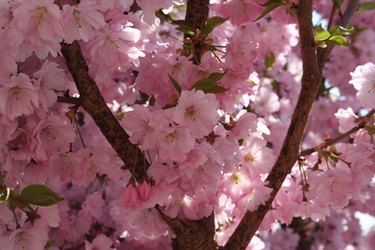
The Chinese plum (Prunus mume) is a rare ornamental tree that has been cultivated in China and Korea for more than 1,000 years. It was first introduced to the United Kingdom in the mid-19th century, but has never been widely used for home landscaping. Its compact size makes it ideal for small yards and gardens. It has dark green foliage and stems and produces a spicy fragrance throughout the year.
Origins
Video of the Day
The Chinese plum, more commonly known as the Japanese apricot, belongs to the Rosaceae family. It originated in southern China and was later introduced to Korea, Vietnam and Japan. It has been used for hundreds of years for its fruit, which is often called a plum, but is more closely related to the apricot. It is also notable for its flowers, which are common themes in art throughout the region. It was introduced to other parts of the world during the 19th century and today can only be found at select nurseries.
Video of the Day
Uses
The Chinese plum reaches an average mature height of 20 feet, making it ideal for small spaces or as an accent in larger spaces. It produces dark green foliage with an oval shape and pointed tips, which can be beneficial if planted as a screen or privacy tree. The fruit is widely used throughout Asia for food and is processed to create a number of products, including liquor and tea. Traditionally, the fruit has been used medicinally to help with fever, cough and in the prevention of heart disease, though there is not enough scientific evidence to support its use. In most areas, the fruit will develop in early summer and produces yellow flesh with yellow or blush-colored skin. Eating the fruit unprocessed is not recommended as it can contain toxins.
Flowers
The flowers of a Chinese plum are one of the plant's defining characteristics. Each flower has five petals and is 1/2 to 1 inch across. They produce a pleasant fragrance and will usually open in late winter, giving the garden a nice burst of color. The petals can be found in white, pink, rose or deep red. The blossoms are generally an early sign of spring in Japan, as they are among the first to open for the season. The plum tree comes in a number of types, some of which have weeping-style branches and flowers with more than five petals.
Conditions
Most varieties of Chinese plum will do well in zones 4 and 5 of the United States. They do not tolerate cold well and should be protected from frost so flowers and fruit don't become damaged. Growers should find a sheltered area with several hours' sunlight per day and nutrient-rich soil that drains well to prevent health problems. Since most aren't self-pollinating, a second tree will be necessary for fruit production. These trees should be planted 18 to 22 feet away from each other to allow adequate space for growth. Once established, the tree will require minimal care, primarily pruning to maintain shape and remove dead material. Upon planting, young trees may require staking to avoid branch damage.